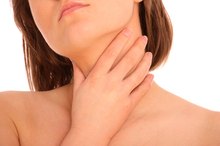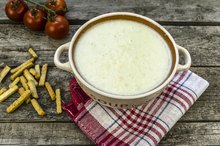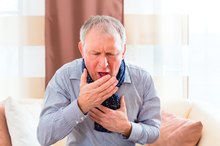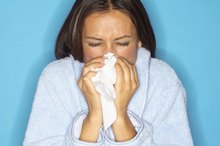My Esophagus Burns When Eating
With the help of the throat muscles, the esophagus relays food and drink to the stomach, keeping the body nourished and hydrated. Burning sensations in the esophagus can make swallowing painful, leading to poor nutrition. Burning in the chest associated with meals may be from esophageal conditions such as acid reflux, inflammation or ulcers. However, pain and burning while swallowing may also relate to conditions that involve the pharynx, or throat, since the throat muscles are so important in swallowing.
If you are experiencing serious medical symptoms, seek emergency treatment immediately.
Gastroesophageal Reflux
Gastroesophageal reflux disease, or GERD, is a recurring problem, with symptoms affecting over 20 percent of Americans 35. It occurs when the esophagus becomes irritated from a back-flow of stomach acid. Prolonged exposure to acid reflux and irritation can result in painful swallowing and other complications because the lining of the esophagus becomes sore and inflamed. Structures in the throat can also be involved. There may be a burning feeling in the chest, throat and upper abdomen -- heartburn -- with other possible symptoms including nausea, vomiting and bad breath.
Smoking and certain medications can further contribute to acid reflux and irritation of the esophagus and throat. Lifestyle changes in combination with acid-suppressing drugs lead to symptom improvement for most people with GERD.
- Gastroesophageal reflux disease, or GERD, is a recurring problem, with symptoms affecting over 20 percent of Americans 3.
- Prolonged exposure to acid reflux and irritation can result in painful swallowing and other complications because the lining of the esophagus becomes sore and inflamed.
Esophageal Pain and Burning
Pain in the Esophagus After Eating
Learn More
GERD is just one cause of inflammation of the esophagus, or esophagitis, and painful swallowing 7. Certain medications and supplements, infections such as candidiasis and radiation therapy may all cause esophagitis 7.
Esophagitis may be associated with painful ulcers and even cellular changes 7.
Eosinophilic esophagitis is a chronic immune disease that's increasingly recognized as a more common gastrointestinal disorder 7. Some people with this condition have pain in the center of the chest that does not improve with acid-suppressing medication.
The lining of the esophagus may be damaged in a number of other ways to produce pain, including swallowing food or foreign objects that scratch the lining as they go down. Problems with the muscular contraction and relaxation of the esophagus can also be painful.
A description of timing and nature of the symptoms, along with tests, can help you and your doctor determine what may be causing your esophagitis or esophageal pain 7. Bring a list of current medications, and let your doctor know about any antibiotics -- even if recently finished -- since some may be responsible for drug-induced esophagitis 7.
- GERD is just one cause of inflammation of the esophagus, or esophagitis, and painful swallowing 7.
- The lining of the esophagus may be damaged in a number of other ways to produce pain, including swallowing food or foreign objects that scratch the lining as they go down.
Pharyngitis
**A sore, scratchy and inflamed throat from pharyngitis can result in painful swallowing and loss of appetite and may be mistaken for esophageal pain.
Pharyngitis can cause the tonsils at the back of the throat to become swollen and sore, which can make eating rather difficult.
** Most cases of pharyngitis are caused by viruses such as cold viruses, the flu or mononucleosis -- conditions that generally go away on their own with time.
However, strep throat -- a bacterial pharyngitis -- is treated with antibiotics. Consulting your doctor's office can help you decide whether it is best to treat the symptoms and wait it out, or whether you need to be seen sooner.
- A sore, scratchy and inflamed throat from pharyngitis can result in painful swallowing and loss of appetite and may be mistaken for esophageal pain.
- Pharyngitis can cause the tonsils at the back of the throat to become swollen and sore, which can make eating rather difficult.
Tonsillitis
Is Kefir Good for Acid Reflux?
Learn More
Painful swallowing can be brought on by throat ulcers and acutely inflamed tonsils in tonsillitis. Tonsils may become infected by some of the same bacterial and viral agents that strike elsewhere in the throat, like streptococcus, adenovirus and herpes simplex. Short-term or acute bacterial tonsillitis can be treated with antibiotics.
Chronic or recurring cases may benefit from surgical removal of the tonsils. Difficulty breathing, voice muffling, drooling or severe throat pain should be addressed immediately, as these symptoms may mean that something called a peritonsillar abscess has developed.
- Painful swallowing can be brought on by throat ulcers and acutely inflamed tonsils in tonsillitis.
- Difficulty breathing, voice muffling, drooling or severe throat pain should be addressed immediately, as these symptoms may mean that something called a peritonsillar abscess has developed.
Precautions and Warnings
While acid reflux is often the cause of that burning sensation in the esophagus around meals, many other illnesses produce painful sensations in the throat and chest.
Painful or difficult swallowing accompanied by the feeling that something is stuck in your throat should be evaluated by a doctor. Seek emergency care if you are vomiting blood or have what appears to be coffee grounds in your vomit.
Pain in the chest should never be ignored.
Heartburn may be mistaken for a heart attack and vice versa -- if in doubt, check it out. Know your risk factors for heart disease, and call for emergency help if chest pain is persistent.
- While acid reflux is often the cause of that burning sensation in the esophagus around meals, many other illnesses produce painful sensations in the throat and chest.
- Seek emergency care if you are vomiting blood or have what appears to be coffee grounds in your vomit.
Related Articles
References
- University of Maryland Medical Center: Pharyngitis
- Yale Medical Group: Tonsillitis
- National Institute of Diabetes and Digestive and Kidney Diseases: Symptoms and Causes of Gastroesophageal Reflux (GER) and Gastroesophageal Reflux Disease (GERD)
- National Institute of Diabetes and Digestive and Kidney Diseases: Definition and Facts for Gastroesophageal Reflux (GER) and Gastroesophageal Reflux Disease (GERD)
- National Institute of Diabetes and Digestive and Kidney Diseases: Treatment for Gastroesophageal Reflux (GER) and Gastroesophageal Reflux Disease (GERD)
- American College of Allergy, Asthma & Immunology: Eosinophilic Esophagitis
- UAB Medicine: Esophagitis
- Harwood-Nuss' Clinical Practice of Emergency Medicine, Fifth Edition; Allan B. Wolfson, et al.
- University of Maryland Medical Center: Painful Swallowing
- Saleem F. Drug Induced Esophagitis. StatPearls [Internet].
- National Institutes of Diabetes and Digestive and Kidney Diseases. Acid reflux (GER and GERD) in adults.
- Furuta GT, Katzka DA. Eosinophilic Esophagitis. N Engl J Med. 2015;373(17):1640‐1648. doi:10.1056/NEJMra1502863
- Rosołowski M, Kierzkiewicz M. Etiology, diagnosis and treatment of infectious esophagitis. Prz Gastroenterol. 2013;8(6):333-7. doi:10.5114/pg.2013.39914
- Contini S, Scarpignato C. Caustic injury of the upper gastrointestinal tract: a comprehensive review. World J Gastroenterol. 2013;19(25):3918-30. doi:10.3748/wjg.v19.i25.3918
- Saleem F. Drug Induced Esophagitis. StatPearls [Internet].
- Baker S, Fairchild A. Radiation-induced esophagitis in lung cancer. Lung Cancer (Auckl). 2016;7:119-127. doi:10.2147/LCTT.S96443
- National Institutes of Health. MedlinePlus. Systemic. Updated March 7, 2019.
- Careta MF, Romiti R. Localized scleroderma: clinical spectrum and therapeutic update. An Bras Dermatol. 2015;90(1):62-73. doi:10.1590/abd1806-4841.20152890
- National Institutes of Health. MedlinePlus. Esophagitis. Updated June 21, 2018.
- Hazelwood RJ, Armeson KE, Hill EG, Bonilha HS, Martin-harris B. Identification of Swallowing Tasks From a Modified Barium Swallow Study That Optimize the Detection of Physiological Impairment. J Speech Lang Hear Res. 2017;60(7):1855-1863. doi:10.1044/2017_JSLHR-S-16-0117
- National Institutes of Health. MedlinePlus. Esophageal manometry. Updated July 11, 2019.
- Grossi L, Ciccaglione AF, Marzio L. Esophagitis and its causes: Who is "guilty" when acid is found "not guilty"?. World J Gastroenterol. 2017;23(17):3011-3016. doi:10.3748/wjg.v23.i17.3011
- Mermelstein J, Mermelstein AC, Chait MM. Proton pump inhibitors for the treatment of patients with erosive esophagitis and gastroesophageal reflux disease: current evidence and safety of dexlansoprazole. Clin Exp Gastroenterol. 2016;9:163-72. doi:10.2147/CEG.S91602
- Kim SH, Jeong JB, Kim JW, et al. Clinical and endoscopic characteristics of drug-induced esophagitis. World J Gastroenterol. 2014;20(31):10994-9. doi:10.3748/wjg.v20.i31.10994
- American Academy of Allergy, Asthma, and Immunology website. Eosinophilic Esophagitis (EoE).
Resources
Writer Bio
Based in Cincinnati, Sarah Williams is a registered dietitian and medical writer. Her research on eating disorders can be found at the Isabel Briggs Myers Memorial Library in the Center for Applications of Psychological Type. Williams holds a Master of Science in dietetics from D’Youville College.








